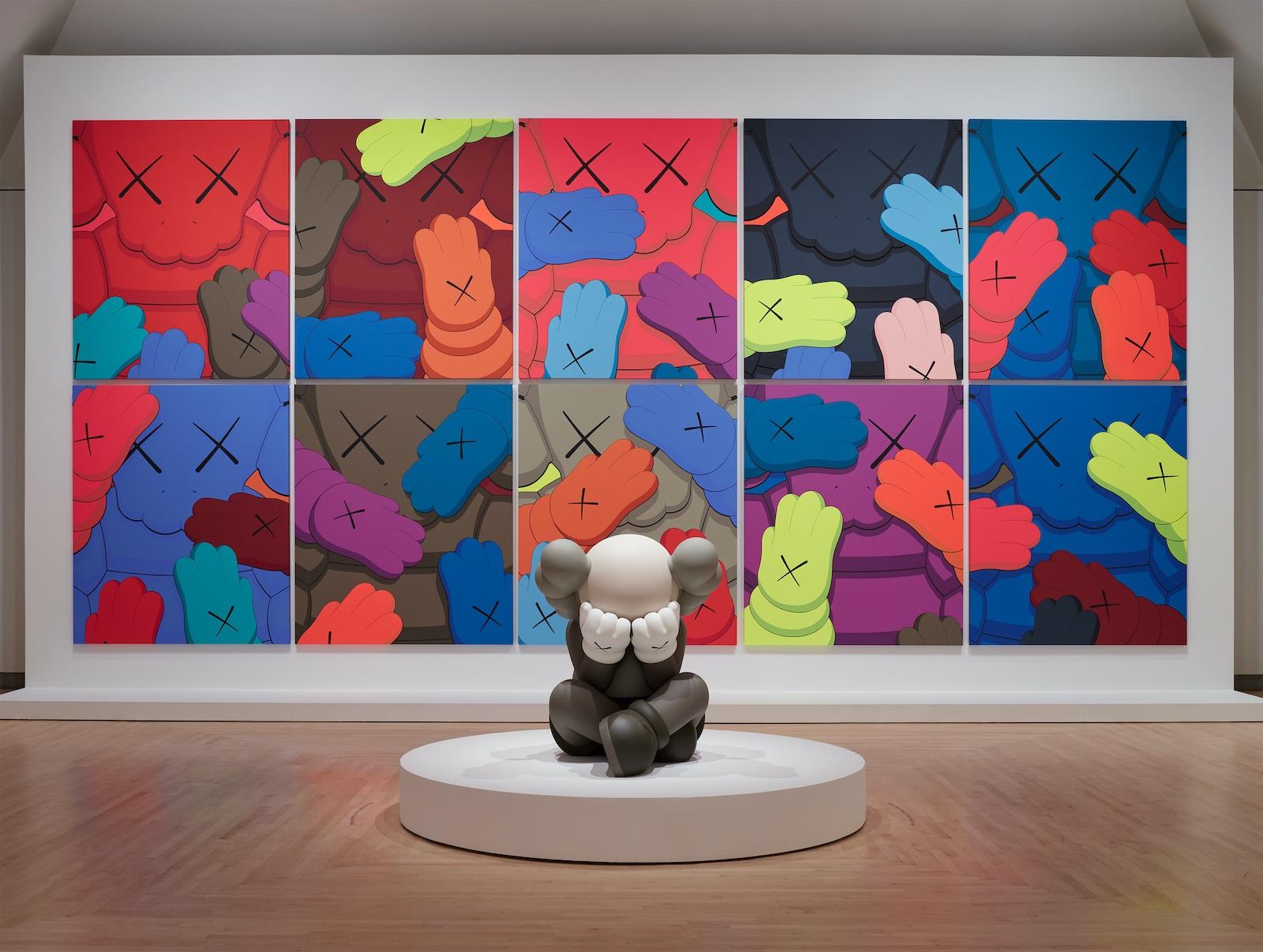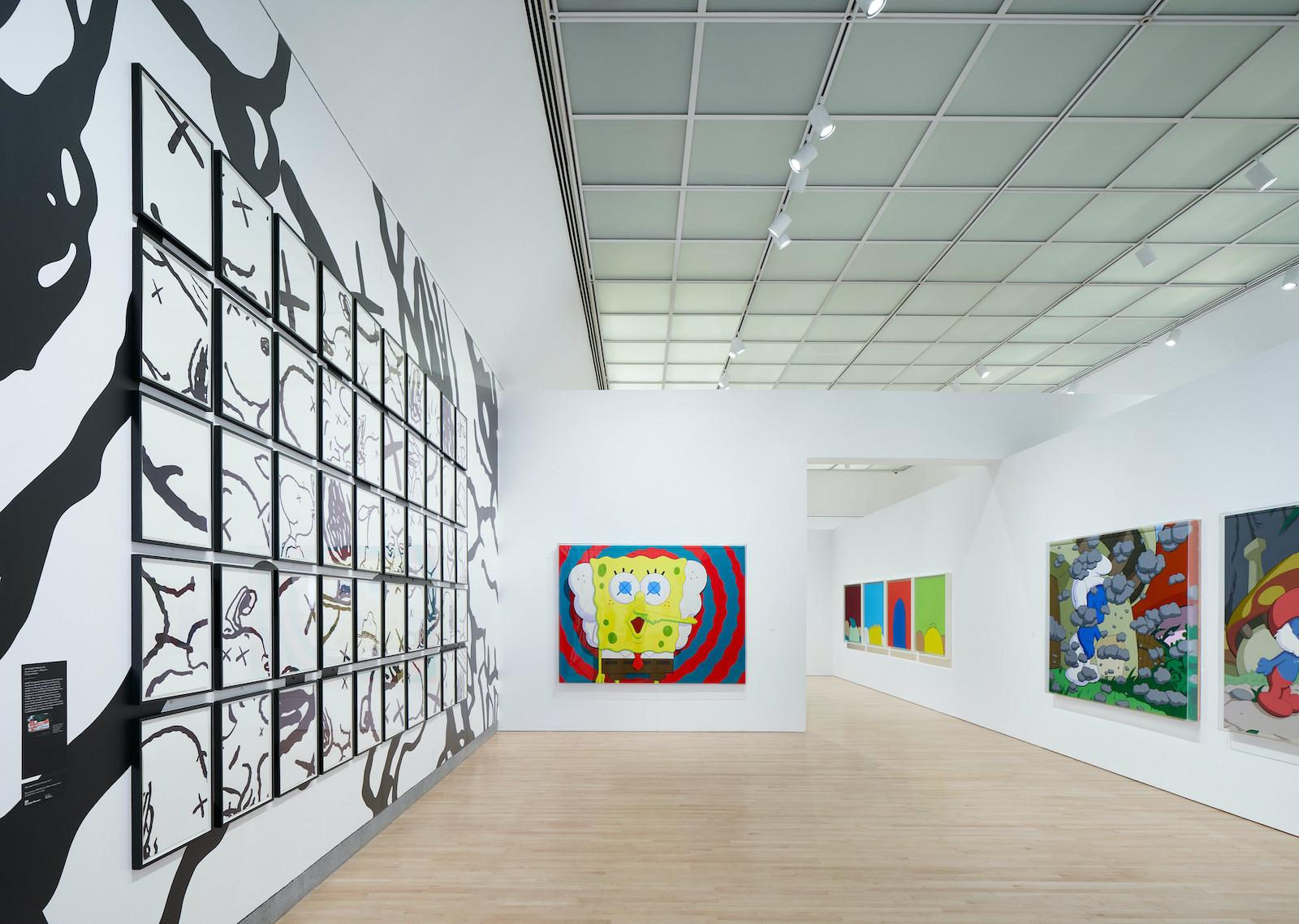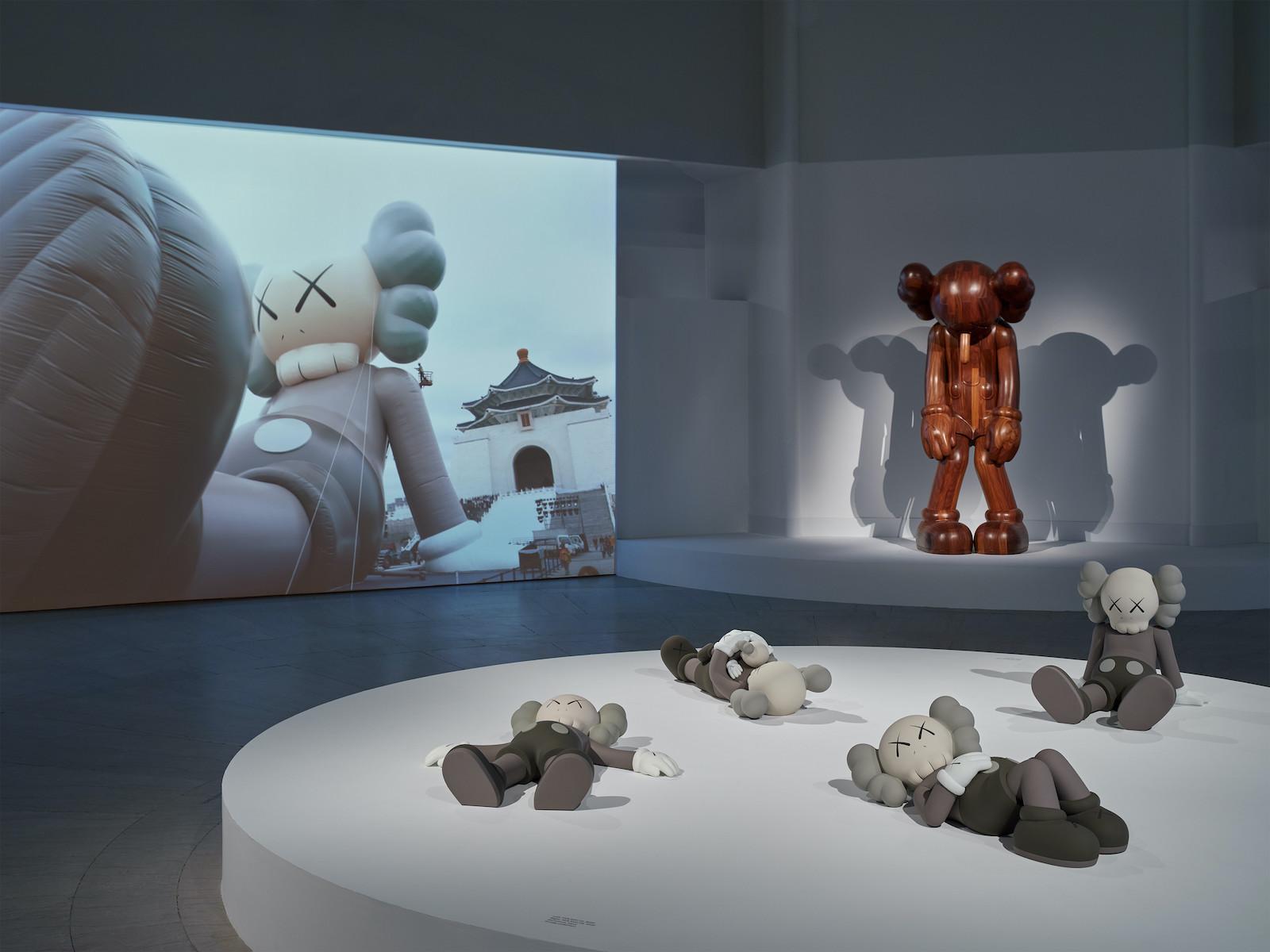From Graffiti to Augmented Reality: KAWS at the Brooklyn Museum
https://www.artandobject.com/news/graffiti-augmented-reality-kaws-brooklyn-museum
From Graffiti to Augmented Reality: KAWS at the Brooklyn Museum

Installation view, KAWS: WHAT PARTY, Brooklyn Museum, February 26, 2021 - September 5, 2021.
One of the most compelling artists to come out of the graffiti and street art scene since Jean-Michel Basquiat and Keith Haring, KAWS has taken the international art world by storm and now the Brooklyn Museum is celebrating his rise. Featuring a dynamic combination of graffiti drawings, paintings, sculptures, collectible objects, furniture, and augmented reality projects, KAWS: WHAT PARTY presents a twenty-five-year survey of the popular artist’s most momentous artworks.
“This is an opportunity to present his career in its entirety, as it stands at this point,” Brooklyn Museum curator Eugenie Tsai tells Art & Object during a walk through the show. “KAWS is a celebrity, but that wasn’t always his goal. We hope our exhibition will broaden visitors’ understanding of his extensive artistic enterprise.”
Starting out in Jersey City as Brian Donnelly, a skateboarder-turned-graffiti artist bombing trains, walls, and billboards with a four-letter tag that he thought looked good and sounded cool, KAWS relocated to New York to study illustration at the School of Visual Arts in 1993. One of the surprises in the show is the presentation of the artist’s early sketchbooks, drawings, and photographs, which reveal his fluid style of graffiti writing and quick grasp of promotional skills through the self-documentation of his ephemeral public works.
Graduating from SVA in 1996, he worked at Jumbo Pictures animation studio for the next six years while developing his initial characters (BENDY and COMPANION) with skull and crossbones heads and X-ed out eyes. He integrated them into printed fashion, product, and entertainment advertisements that he would remove from bus shelters and phone booths, paint at home, and then return to their display cases, where the altered imagery would confront and confound viewers.

KAWS, Interior spread from UNTITLED (Blackbook), circa 1993. Photograph, ink on paper, 12 1:2 × 8 in. (31.8 × 20.3 cm).
“I was looking for interesting ways to interact with the image,” KAWS told this writer in a 2012 interview for FLATT Magazine. “I felt the ones that wrapped around the subjects worked really well with the fashion advertisements that I was going over. It was really about color and composition and how it read—as part of the ad rather than on top of it. I wanted people to do a double-take and wonder what they were looking at.”
There are four examples of these altered ads in the exhibition. One of them shows a model wearing a bra in a Maidenform ad with a skull and crossbones head and X-ed out eyes, while the other three show a spermazoidal character (the artist’s BENDY figure) with a similar head embracing the subjects in the ads, with two of them being female fashion models. However, one of the manipulated ads is revealing in another regard, because BENDY is wrapping an image of Keith Haring from the poster for his 1997 Whitney Museum retrospective. The image shows Haring making a chalk drawing on the black paper used to cover expired subway ads—an action that was directly related to what KAWS was doing by co-opting commercial space for his art.
In that same year, KAWS began visiting Japan, where he infiltrated the subculture of graffiti, fashion, and toys and soon began collaborating with the fashion brand A Bathing Ape and the toy producer Bounty Hunter. In 1999, he produced his first editioned object, COMPANION, a vinyl toy figure with his signature skull-like, eyeless head on the body of a Mickey Mouse-sort-of-character wearing shorts, gloves, and booties. The success of these commercial projects led to increased notoriety and both the money and opportunity to make more works for exhibitions.
“I always find an artist’s early work fascinating because there are so many clues about their interests and then you can see where they subsequently decide to go,” Tsai notes. “It’s not a linear thing—you just see the seed and then discover that they decided to pick up on this in one body of work and then they are working on that. The idea of branding—of putting yourself out there as a graffiti artist—relates to KAWS’ making of toys, which can travel in the world in the manner that graffiti writing does and make [their] way into all kinds of unsuspecting homes and corners of society.”

KAWS, UNTITLED (DKNY), 1997. Acrylic on existing advertising poster, 49 7:8 × 25 7:8 in. (126.7 × 65.7 cm).
KAWS created his first cartoon paintings featuring The Simpsons for his solo show at Tokyo’s Parco Gallery in 2001. For it, he made a set of small paintings of the Simpson family with his signature heads and presented them in oversized, custom-printed blister packaging, like they were plastic-wrapped commercial products, and created another group of larger canvases that partially abstracted Crusty the Clown and Bart, Marge, and Homer Simpson.
In 2005, Nigo—the creator of A Bathing Ape—commissioned KAWS to create paintings for the BAPE Café, which led to the now-famous THE KAWS ALBUM painting. Riffing on the Simpsons 1998 record cover for The Yellow Album, which in turn was a clever mashup of the covers for the Beatles Sgt. Pepper's Lonely Hearts Club Band and The White Album, the painting presents all of the show’s cartoon cast as KAWS characters, comically rebranding them as THE KIMPSONS.
Through Nigo, who collaborated with the artist again in 2018 when he was the creative director for Uniqlo's UT brand, KAWS met musician and record producer Pharrell Williams. The “Happy” songwriter commissioned him to make paintings for his Miami penthouse apartment, which coincidentally led the artist to his first high-profile gallery, Perrotin, which had spaces in Paris and Miami at the time and now has branches in Paris, New York, Hong Kong, Shanghai, Tokyo, and Seoul.
“A lot of the stuff that happened for me was organic,” KAWS added in the FLATT conversation. “I met Pharrell because my friend Nigo had commissioned me to do a lot of work for his house. At the time Pharrell was going to Tokyo and saw my work there. Every time he went, he asked Nigo about it. Through that connection we met and later Perrotin was at Pharrell’s place in Miami and saw my work. Pharrell made the introduction and then he curated my first show at the gallery, with several works from his collection.”

KAWS, UNTITLED (KIMPSONS #2), 2004. Acrylic on canvas, 80 × 80 in. (203.2 × 203.2 cm).
Three large paintings from 2007—KAWSBOB 3, which shows SpongeBob SquarePants with X-ed out eyes in front of a wobbling target, and KURFS (CLOUD) and KURFS (PAPA), that appropriate Smurf characters as subject matter—have been lent by Williams for the Brooklyn Museum survey, where they are in the company of other cartoon, children’s television, and advertising personalities, including characters from Peanuts, Sesame Street, and Gumby as well as the tubby tire figure known as the Michelin Man, who KAWS has rebranded as CHUM.
Sesame Street’s Cookie Monster, one of KAWS’ BFF figures, is seen in the 2018 painted bronze sculpture GONE, where COMPANION is carrying BFF in his arms, which is a take on Michelangelo’s famous Pietà, a sculpture of Jesus being cradled by his mother Mary. In the 2019 shaped canvas CHUM (KCC7), Sesame Street’s Elmo pops through a CHUM character as it advances toward the viewer. And KAWS Chair Pink (Pink BFF PLUSH), his 2018 design collaboration with the Campana Brothers, stitches dozens of stuffed BFF figures together to create a big pink cushion for a stylish and comfy chair.
COMPANION, who was famously flown in Macy’s Thanksgiving Day Parade as a giant inflatable balloon in 2012, also makes multiple appearances in a variety of different materials and sizes—ranging from small pencil drawings and vinyl toys to large sculptural figures in fiberglass, bronze, aluminum, and wood and an augmented reality character that can be activated on viewers’ smartphones and cast afloat wherever they are located. As Williams prophetically conveyed to Serena Altschul in a 2012 CBS Sunday Morning segment on KAWS, “To our generation, we’re going to look at him like he’s the guy that made us pay attention to art.”
Recent paintings present the artist as an endlessly skilled draughtsman and colorist. Painted in a “Superflat” style—a term coined by Takashi Murakami to describe a two-dimensional rendering of subject matter that draws upon contemporary Japanese subcultures and the influences of Pop Art, while also making references to consumer culture—canvases such as MIRROR and SCORE YEARS reveal KAWS’ ongoing interest in abstraction, whereas his jumbo ten-panel URGE painting offers a compelling use of figuration to comment on the Covid-19 crisis with repeated images of CHUM touching his face.
The far-reaching exhibition additionally boasts drawings for countless collaborative projects; an assortment of small sculptural figures, including the KAWS MTV MOONMAN for the 2013 MTV Video Music Awards; skateboards, mousepads, and sneakers; a graphic perfume bottle that he designed for Comme des Garçons X Pharrell Williams’ GIRL; diagrammatic charts for the color combination of his paintings; and big-screen projections showing installations of his giant inflatable figures displayed in various sites around the world.
Sharing Andy Warhol, Keith Haring, and Takashi Murakami’s appreciation for pop culture content, repetition, and inflated scale, while equally embracing the post-painterly abstraction and shaped canvases of Frank Stella and Elizabeth Murray, KAWS filters art historical styles through his studio practice to create striking new artworks that astutely respond to contemporary times.
“Warhol started out as a commercial artist and made work to promote products, while KAWS creates products,” Tsai says while summarizing the show. “He’s abolished the line between high and low culture and doesn’t shy away from what used to be called commercialism because he understands how much joy ownership can bring. If you like an artist, have his skateboard or sneakers, and it brings you joy every day, it can be as valuable as owning an expensive painting or sculpture. I appreciate his desire for accessibility, not just in price point but also in content, in making things that bring out empathy. His works affirm the importance of humanity, which was one of the reasons that it was such a joy to work on this show over the past year. His subjects are an affirmation of joy, creativity, and human relationships—even though they aren’t always happy, which is ultimately who we are and what makes us tick.”



Comments
Post a Comment